The Savonnerie weaving technique
An origin ” from Türkiye and the Levant ”
When Pierre Dupont, upholsterer, introduced the knotted stitch technique “ Turkish and Levantine style ” to the Louvre, he wanted to compete with the carpets imported at great expense by the aristocracy of the Kingdom.
Let the Turks and Persians no longer praise their art
Pierre Dupont, La Stromatourgie
To make carpets, it’s now France
Who today has the perfect science
Of which DUPONT, the only author, made public.
If the iconographic vocabulary and the organization of the composition found a specifically French expression from the second half of the 17th century (see The productions of the Savonnerie manufactory in the 17th century), the gesture and the tools used underwent little change.

The Savonnerie, a technique for “transforming matter into meaning” (Anni Albers)
The Savonnerie technique is carried out on a high warp loom, i.e. a vertical loom, favored for producing compact weaves. It is made up of two uprights in which the rollers are embedded.
After a warp preparation stage called warping, we assemble the loom. That is to say, we wind the warp threads, traditionally made of wool, around the bottom roller, then around the top roller in order to tension them between the two rollers. We thus obtain the vertical structure of the weave.
Fundamentally, a fabric results from the interweaving of threads at right angles, and Savonnerie weaving is no exception to the rule. The warp, threads stretched vertically on the high warp loom, is made up of a front shed and a back shed, separated by a shed stick ; Using a special bobbin loaded with threads of wool, we pass the pick horizontally, going straight in the gap between the front and back sheds ; then the weft which goes over and under each warp thread across the entire width of the weave.
To facilitate the gesture and speed up the process, each of the rear warp threads is attached by means of loops to the heddle rop placed above our head. These loops, made of cotton and called heddles (lisses in French), allow us to easily bring our back warps to the front of the weaving.
It is these cotton heddles which are at the origin of the name of our profession: lissier, or in our case lissières.
These gestures, common to the high warp weavers of Gobelins and Savonnerie, result in a flat fabric in which the weft covers the entire warp, characteristic of tapestry. In Savonnerie, we call this part of the weaving the selvage. It serves as a base and frames the weaving.
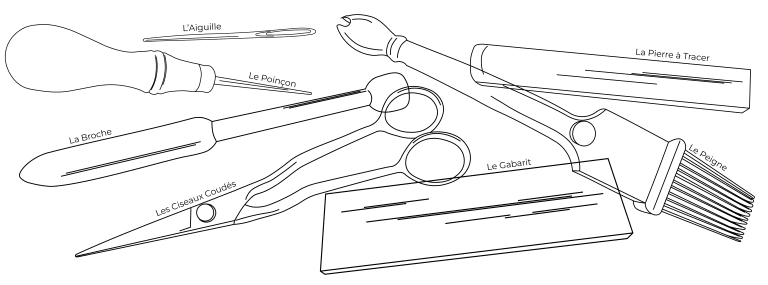
The revelation of the woven pattern into the velvet
But the whole point of Savonnerie lies in its very dense velvet. We obtain it by making a succession of knots, row after row. There are different knotting techniques around the world, which have evolved over the centuries and according to localities. The most common are symmetrical and asymmetrical knots, made on two warp threads. The Savonnerie technique uses the symmetrical knot, also called the Turkish or ghiordès knot.
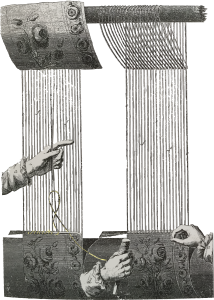
This consists of passing the threads of wool around a front warp thread then around the corresponding rear warp thread. This operation is repeated over the entire width of the weave. After making the knots across the entire width, we pass the pick, double linen thread, in the gap between the sheds ; and the weft, a single linen thread that winds back and forth between each warp thread.
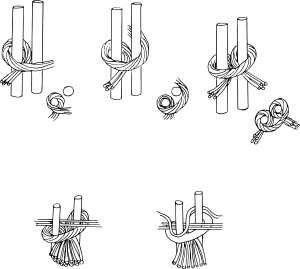
Once these steps have been completed, we pack the row of knots, the pick and the weft using a heavy toothed instrument, the comb. The knots are blocked, we can proceed with shearing: with a pair of curved scissors, we cut the loops obtained between each knot, guiding our action using a wooden template whose thickness determines the height of shearing. The pile of a Savonnerie carpet is approximately 6 to 8 millimeters.
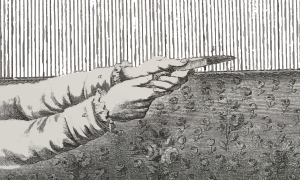
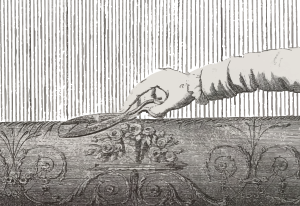
All of these operations are repeated, row by row, over the entire height of the weave.
The density of the Savonnerie weaves is particularly remarkable due to the significant withdrawal of the front warp threads compared to the rear warp threads. Moreover, if we look at the reverse side of a Savonnerie rug, the ribs are very tight and we only see the part of the knot which encloses the rear warp threads, the other disappearing completely. This particularity appears in the structure of Savonnerie carpets from the mid-1660s, the Louis XIII style creations being less compressed (consult The productions of the Savonnerie manufactory in the 17th century).
Since each knot, and even each threads of wool that makes up the knot, can be of a different color, the possibilities offered by this technique are almost unlimited in design. Flat areas, mottled colors, delicately blended gradients, stripes, geometric designs or sinuous lines… The weaver has an infinite palette of interpretations that he deploys according to the needs of the carton (= model) he wants to weave. Before starting weaving, we go through a preparatory stage of analyzing the model in order to determine the technical writing to use. We then transfer these indications in Indian ink using a tracing stone on each of the front warp threads, in order to guide us throughout the weaving.
The finishing stage of rangement, specific to the Savonnerie technique, consists of regularly storing and felting the shorn peels of wool with the tip of the scissors, in order to tighten the lines, clarify the patterns drawn in the velvet and make so that they no longer move afterwards.
An object that crosses time
Because we must keep in mind that the Savonnerie carpet is a functional object, whose structure must resist trampling, while maintaining the beauty of its surface.
Wefts, picks, knots, everything is replaceable. Indeed, the Savonnerie carpet being entirely made by hand, the slightest damage due to use or time can be restored using scissors, needles and other tools essential to the intervention of the returners/restorers. carpet.
Conservation work can reduce the deterioration of a piece by following simple rules of humidity (ideally 40 to 50%), frequent dusting and limiting direct exposure to the sun’s rays, for example.
Sources :
- Anni Albers, On Weaving. Princeton University Press, 2017.
- Thierry Sarmant (directeur de publication), Créer pour Louis XIV : Les manufactures de la Couronne sous Colbert et Le Brun. Silvana Editoriale S.p.A., Milan, 2019.
- Taher Sabahi, Splendeurs des Tapis d’Orient. Groupe Guilde Editions Atlas s.a., Paris, 1987.
- Dupont, La stromatourgie de Pierre Dupont : documents relatifs à la fabrication des tapis de Turquie en France au XVIIème siècle. Edition par Alfred Darcel et Jules Guiffrey, Paris : Société de l’histoire de l’art français, 1882.
- Mobilier National website : https://www.mobiliernational.culture.gouv.fr/fr/nous-connaitre/les-manufactures/manufacture-de-la-savonnerie
The illustrations, taken and modified, are taken from volume 9, plate 8 of the Encyclopédie of Diderot and d’Alembert.
